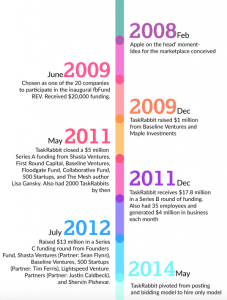Crowdsourcing your Day

TaskRabbit is a two-sided crowdsourced marketplace model that connects TaskPosters, people who need help completing tasks to Taskers, people who are willing to complete the tasks.
How it Works:
- TaskPoster posts a job and is able to view 3 contractors that meet their needs
- Taskers are able to accept or cancel the job
- The payment is processed by TaskRabbit when the Tasker completes the job
Evolution of Business
As the company grew, they had to make some changes to the service in order to better manage the crowd and make sure both sides of 
the marketplace were properly incentivized. There were three major shifts the company made.
First, they removed the auction-based task system originally put in place and instituted a direct hire model. Taskers felt the auction-based system was encouraging TaskPosters to offer lower wages and that in order to ‘win’ a job they had to accept lower wages than
they normally would. As a result of this dissatisfaction, TaskRabbit started to notice reduced crowd participation on the Tasker side through lower bid rates. The company was smart to make this change to keep the Taskers properly motivated since crowd participation is key to the success of a crowdsourced marketplace.
TaskRabbit also increased the accountability of the Taskers in order to better manage the quality of the experience. Taskers were required to respond within 30 minutes to job
assignments, update their availability information and even wear TaskRabbit uniforms. These measures taken helped to ensure a higher quality experience for the TaskPosters which in turn incentivizes them to use the service again or recommend it to friends.
Finally, TaskRabbit switched from a task rate to an hourly rate system. TaskPosters were miscalculating the amount of time the task would take to complete and therefore Taskers were investing more time than expected for a pre-agreed rate. The hourly rate allowed for more flexibility if tasks took longer and was more aligned with the way Taskers were comfortable being paid.
Value Creation
TaskPosters are provided with an easy solution to finding Taskers that have been vetted. The safety checks performed by TaskRabbit create a level of trust for its users. Additionally, every task is insured, which further increases this trust.
Taskers are able to make quick, easy money on their own schedule. They can select jobs that they want to do
with the flexibility to do them when they want at the price they want.
Value Capture
TaskRabbit gets a 30% commissions on each transaction between the TaskPoster and the TaskRabbit. Additionally, they charge a 5%
trust and safety fee that is added to the total of the task.
Challenges
While TaskRabbit has done a good job scaling the business, they certainly face several challenges that could impact the future of the business. First of all, they are a location-constrained marketplace, which makes crowd participation and size that much more important. Additionally, they run the risk of meeting challenges around whether the Taskers are considered independent contractors or TaskRabbit employees, which could have income tax implications for the business.
The company has been able to scale through indirect network effects. With the new model that is hire only instead of auction-based, they are removing the visibility of the Tasker network and I worry that might impact their ability to scale since the TaskPosters are only  getting 3 options now.
getting 3 options now.
Finally, when thinking about incentivizing the crowd, it is clear this community is motivated by extrinsic motives and since multi-homing is possible, there is a risk that a new competitor could enter and offer lower commissions and easily steal the user base.
It will be interesting to see how they handle these challenges and also to see what will happen with Uber now in the mix.



Great post, it’s good to see the company has responded to the crowds’ worries and has kept its relevancy with the users / almost became a household name. I think the local aspect of the platform is an asset so people can focus on what is relevant and spend less time selecting the right person for the job. I wonder how TaskRabbit will protect its marketplace or relevance with competitor services such as Thumbtack pecking directly at the local services market and allows people to get quotes from professionals (no 3 person limitation). Thumbtack still has the bid based approach and at this stage it’s not very clear which is preferable to which party. As long as hourly rate is a reflection of efficacy, professionalism etc Task Rabbit’s model should work just fine. Thumbtack’s “pay for introduction model” is I believe a superior measure of ensuring the customers get quality bids, similar to Upwork’s model. Future will tell how Task Rabbit will respond to the aggressive move of Thumbtack and other services.
I’ve had 2 odd jobs done through TaskRabbit. It’s a good service from my experience.
I think the changes to display only 3 taskers and set hourly rates are great for frequent taskers but wonder how this is translating to growth in the broader tasker network, including those who use this as a short-term/part-time source of income. The more reliant a tasker is on TaskRabbit for income, the more tasks they will complete, the more reviews they will have, and the stickier they become. However, I think these recent changes push the majority of less frequent taskers to different platforms and encourage multi-homing where they can do their preferred jobs at the right price. Another problem is the variety of jobs. Unpredictability for the tasker is not something that breeds loyalty for the platform. They may prefer to stick to cleaning (i.e. stay on the Handy platform) or stick to driving (i.e. Uber or Lyft), whatever pays the best rate and is most convenient for them.
Finally, ratings for users requesting taskers mean next to nothing on a platform like this. Network effects are extremely weak. You can join, connect with Facebook, and have a tasker lined up same-day. Multi-homing is a big challenge for TaskRabbit.
I really think that the struggle here would be making sure we have enough task posters and tast takers globally, and not just in specific concentrated geographies. How can they make sure this is the case without marketing it locally?
I agree that the location-centric model of Task Rabbit’s platforms is one of its biggest challenges. Although it is concentrating on 3 main categories of tasks now, it is still more general than other niche apps that are emerging (e.g., Homejoy, Washio), and I believe this will be a big barrier to growth. Its challenge is similar to Craigslist – a local marketplace for everything for everyone, that is being disrupted by platforms focused on specific niches (e.g., dating/personals, events, housing). Networks and crowds often work best when they are focused around a specific idea.
TaskRabbit is a fascinating service. The indirect network effects have proved to be quite successful to date. I’m excited to see how it expands in the future.
Great post! Really interesting to read about a double-sided crowd-sourced platform. It definitely adds to the complexity (and importance) of ensuring appropriate participation on both sides. I think the challenges you laid out are spot on, especially the part about being location-constrained. The scale, participation, and ultimately the network effects could be a challenge in specific, smaller geographies. On the flip-side, this could be an opportunity to leverage in other larger geographies. It will definitely be interesting to see how this company competes in smaller markets and how they fend off competitors who are chomping at the bit to steal share.
Can’t wait to read the next one!